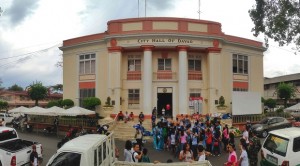
PEOPLE gather outside Davao City Hall as the city celebrates its 77th foundation day. INQUIRER MINDANAO
DAVAO CITY–Along J.P. Laurel Highway, the loud throbbing of a diesel-fired power plant drowns out the noise of traffic, as the frenzy for the upcoming Araw ng Dabaw, celebrating the birth of the city 77 years ago, reaches fever pitch.
With malls and boutique hotels looming over the curving road and new high-rises fast changing Davao City’s skyline, longtime residents, who have been here before everything happened, regard the new developments as a long, long way from what used to be their close-knit community where everybody used to know everybody decades ago.
Businessman Sebastian Angliongto, who considers himself a man as “old” as the city since he was born only months before Davao City’s founding, remembers himself as a boy taking a dip in the clean and pristine waters of the Santa Ana wharf and walking all the way to take another plunge into the bucana (estuary) to wash the salt off his body in the river water.
“It is not the same environment as we have now,” he said in a matter-of-fact way.
“It was more natural,” he said. “Every household used to have a tank to store rainwater, but now, we ought to be proud that we already have the Emergency 911 and we have the best water in the world.”
“It’s a far cry from the community I grew up in,” said Ivan Cortez, 42, who heads Davao City Investment Promotion Center.
“The whole community used to be connected by wooden bridges because everywhere we went there used to be water,” he said.
Rural setting
He remembers walking to school and elsewhere, on narrow, wooden bridges.
“There used to be creeks and brooks crisscrossing the city,” said Angliongto, also remembering the earlier times.
But where there used to be swamplands covered by thriving nipa fronds, now rise first, the old Victoria Plaza mall in the 1990s, and, in recent years, Abreeza, the first big project of Ayala Land in the city in a joint venture with Davao’s Floirendo family. Only a few blocks away to the north emerges the high-rise condominium development introduced by Camella Homes, and further away to Lanang, sits another premiere lifestyle mall of SM.
Cortez said investments reached its peak of P5 billion to P6 billion a year in 2008 and 2009, when the two malls (Abreeza and SM Lanang) decided to invest here. City officials have been so confident in the city’s bullish investment climate that they are now revising the Davao City Investment Incentives Code to encourage more low-cost socialized housing, this time, after realizing that, with or without incentives, property development projects are bound to come in anyway.
Angliongto said he was not surprised at all that business had been bullish.
“Davao City has its seaport and international airport, making it easily the center of trade and investments in Mindanao,” he said. But he warned that instead of resting on its laurels, Davao City should learn lessons from the mistakes of the past, and plan 30 years or more ahead to anticipate the demands of the future.
Planning ahead
“Our airports and seaports are very valuable things, which we should not lose sight of,” he said, recalling that during the launching of the Davao-Clark direct flights in recent years, calls for an open sky policy were resounding.
“With these developments, Davao City has to consider its absorptive capacity for investments,” he said.
“There’s a need for a fallback, an alternative site for an even larger airport,” he said.
For him, Davao can only participate in the competitive atmosphere of open skies if it will have state-of-the art facilities. “If that happens, I think that the existing 200-hectare area of the present airport will only be confined to domestic flights,” he said.